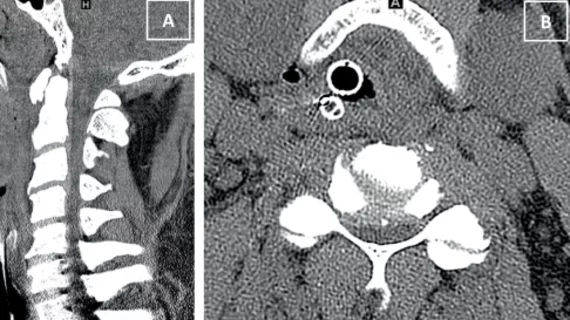CTs of adults with degenerative changes should be met with high suspicion for spinal cord injury following trauma
Patients with congenital stenosis and degenerative changes are at an increased risk of having acute cervical spinal cord injuries (C-SCI) missed on CT scans following injury.
This is something that radiologists should be mindful of when interpreting CT exams of patients with such conditions when trauma is involved, regardless of severity, authors of a new paper in Clinical Imaging recently suggested.
Spinal cord injury without computed tomography evidence of trauma (SCIWOCTET) is an occurrence recognized in adult patients, but research quantifying canal compromise involved in SCIWOCTET remains limited, corresponding author of the new paper Vikas Jain, with the Department of Radiology at MetroHealth Medical Center in Ohio, and colleagues explained.
“Increasingly recognized as a potentially underreported phenomenon, accounting for roughly half of all C-SCIs in certain populations, additional data regarding the degree and mechanisms of canal compromise in SCIWOCTET are needed,” the authors noted.
The team sought to better describe image findings associated with SCIWOCTET to help guide the decision-making process for clinicians treating patients who might have sustained a spinal cord injury due to trauma. To do this, they retrospectively analyzed the cases of 96 adults treated for acute cervical SCIWOCTET at a single level 1 adult trauma center over an eight-year period.
Nearly half of the patients had sustained what would be considered a low-energy trauma—a fall from standing. On CT, 89.6% of patients displayed congenital cervical stenosis (CSS) and 99% showed degenerative changes. In 99% of patients, the point of lowest midsagittal canal diameter (SCD) was less than or equal to 8 mm.
The presence of both conditions (as was the case in the majority of the patient sample), could make patients more susceptible to sustaining a serious spinal cord injury from a minor trauma, the authors explained.
“The simultaneous presence of both CCS and degenerative changes may narrow the AP diameter of the cervical canal beyond the threshold at which low energy trauma results in cervical cord injury despite no evident osseous injury,” the team noted, adding that this is less likely to occur when only one of the conditions is evident.
Outside of focusing on spinal fractures, dislocations/subluxations and bony malalignment, clinicians also must carefully analyze chronically stenotic regions (degenerative or congenital) of the canal following trauma, as they could contribute to acute neurologic injury, the authors suggested.
“A tight, unforgiving cervical canal may lead to cervical SCIWOCTET in the patient without evidence of bony injury to the cervical spine on CT,” the group wrote.
While acute changes in these patients were not evident on CT, the majority of patients displayed abnormal findings indicative of acute trauma on MRI; these included cord edema/contusion, ligamentous injury, intramedullary cord hemorrhage and epidural hematoma. When available, MRI should be considered in cases of SCIWOCTET, the authors suggested.
When it isn’t, clinicians should approach patients with trauma (even low-energy trauma) with a “high level of suspicion” for cervical spinal cord injury, the authors suggested.
The study abstract is available here.

